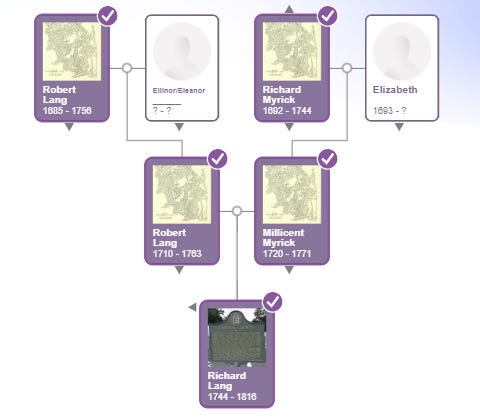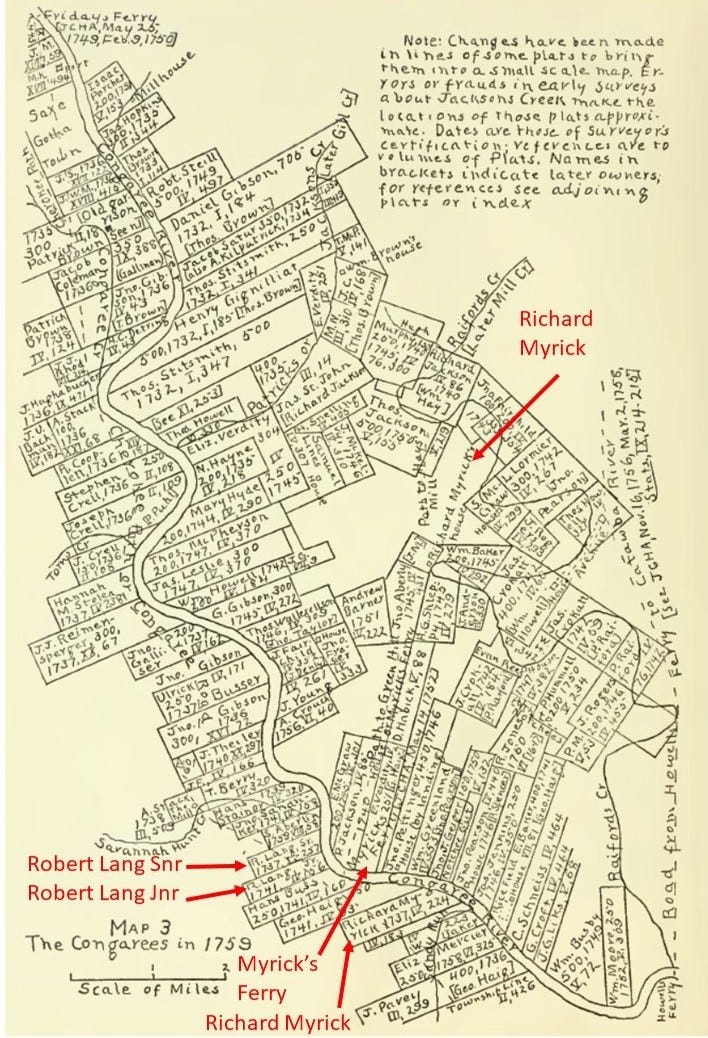Richard Lang: #1 Overview and Family Background
The Life and Times of Richard Lang (1744-1817), His Family and Other Related Matters
Much of what I know about Richard Lang and his family comes from secondary sources which is not ideal. Both information and evidence are incomplete in places.
This post is the first in a series of posts about Richard Lang, his family and other related matters.
Overview
Richard had an eventful life. Too much to tell you about in just one post. I plan to share what I know about him and his family across several posts.
This first post is predominantly about Richard’s family background and childhood setting. However, first I will tell you about what prompted my interest in Richard in the first place.
Later posts in this series follow Richard as he transitions from Loyalist soldier during the American Revolutionary War to refugee in East Florida to Spanish Citizen who turns rebel and eventually to American Citizen in Georgia. Along the way there will also be mention of Richard’s family and other related matters.
My Interest in Richard Lang
I first became interested in Richard when he kept popping up as my 4th great grandfather on people's family trees, including the trees of my DNA matches. Lots of trees show Richard as the father of my 3rd great grandfather, William Lang. However, nowhere have I found documentary evidence sufficient to confirm that. If you know of any, please let me know.
DNA🧬 suggests that I am related to Richard somehow and, when considered alongside the scant documentary evidence found so far, he is just as likely to be my 4th great grand-uncle (5th great uncle) as my 4th great grandfather. I am definitely related to him somehow but DNA analysis is inconclusive. More about that in a later post.
Regardless of whether, or how, I am related to Richard, I have always felt somewhat drawn to him. He features in a number of historical and/or academic writings. Some writers are disparaging of him, others see him as a product of the circumstances within which he found himself and are kinder to him.
Richard’s Family Background
Richard was the son of Robert and Millicent (Myrick) Lang, both of whom appear to have been born in British America. Things are a bit murky as far as documentation goes but it appears that it was Richard’s grandfather, also Robert, that was the Lang immigrant to America, possibly from England. The Myrick (Merrick) line appears to go back to Wales several generations before Millicent was born.

From the mid-1730's, Richard's father, Robert Lang, and his grandfather, also Robert Lang, were Cherokee and Chickasaw traders in the Congarees.
The Congarees was a major destination for Indian traders from the Virginia/North Carolina border in the 1730's-40's. People, with documented residences, who came there from the North Carolina/Virginia border in the 1730's-40's included Richard's father, Robert Lang, and paternal grandfather, Robert Lang, his maternal grandfather Richard Myrick, and his mother’s brother, James Myrick1.
On 5 June 1742, two years before Richard was born, both his father, Robert, and paternal grandfather, Robert received a Royal Grant of 150 acres from King George III on the Santee River in Saxe Gotha Township in the Upper Congaree Valley within the British Colony of South Carolina2. The land received by the younger Robert (Richard's father) was later, on 11 May 1744, sold by him and his wife, Millicent, and conveyed to Thomas Brown3.
At the time of Richard’s birth in 17444, his family was living near the Santee River at Saxe Gotha Township.
Saxe Gotha Township
Saxe Gotha Township was on the south side of the Congaree river. The Trading Post at the Township was the frontier centre for trade with the Catawbas to the north and the Cherokees to the west5.
The township was initially called Congaree Township. It was amongst the first of the townships created under the 1730 Township Act; an Act passed by the, then, British Colonial Government. The Act authorised nine townships of 20,000 acres each.
‘In 1733 the governor and council ordered a township marked off at the Congarees. With its reserve it extended from Sandy Run on the Congaree beyond Twelve Mile Creek on the Saluda, but the strip of desirable land was little more than a mile wide at any point. The town, eventually known as Saxe Gotha, was laid out just above the old garrison site with its Front Street paralleling the river bank for nearly a mile, and a reservation for a fort at its northern end. The ground was level and fertile and the location convenient’6
Following the passing of the 1730 Township Act ...
‘… agents were sent to Europe to recruit families as settlers. The families were offered inducements such as free transportation to South Carolina, free provisions for one year, and free land’7
The name was changed from Congaree Township to Saxe Gotha Township in 1735 to honour the spouse of a member of the British Royal Family, who was born in the area of Germany known as Saxe Gotha. It was in this same year that the first group of German settlers arrived8
Today the area that was Saxe Gotha Township comprises the south-eastern third of what is present-day Lexington County, South Carolina. The current town of Congaree in Lexington County, South Carolina is roughly where the centre of Saxe Gotha Township was9.
The map below has been modified by me to show where the two Robert Langs had land. It also highlights the land belonging to Richard’s maternal grandfather, Richard Myrick. On the bottom left of the map, the references to the two Roberts and to Richard Myrick are:
R. Lang, Sr. 1737, IV, 257
R. Lang, Jr. 1741, IV, 156
Richard Myrick, 1737, IV, 224
and towards the right side of the map, the reference to Richard Myrick is:
Richard Myrick’s house
There is also reference to Myrick's Ferry which, presumably, ferried people and goods across the Congaree River.

Notwithstanding the reference to 1759 on the map, it appears that the Lang family had moved away from Saxe Gotha by 1759? They may, of course, have stilled owned land there?
On to the Saluda Valley
Within a few years of Richard's birth, the family had moved to the Saluda Valley, now Greenville County, South Carolina.
In April 1748, Richard’s father, Robert, was among those living in the Saluda enlisted as Rangers by Captain James Francis. Robert Lang held a warrant as a Ranger in the Saluda Valley from 1749 to 1755.
The need to enlist Rangers came about because of the capture of Captain George Haig, the murder of a trader in the Cherokees, and other threats of an Indian outbreak10. George Haig, deputy surveyor of Carolina, fur trader, magistrate, and land speculator, was abducted from the Store and Trading Post of Thomas Brown at Fort Congaree and held for nearly a year before he was killed11.
On 28 March 1753, Richard’s father purchased 100 acres of land near Crims Creek [Plat 5:498]12 (now Newberry County, South Carolina) where the family then settled. Crims Creek is a branch of the Broad River in the Saluda Valley.
In 1757, when Richard would have been about thirteen years old, his father, Robert, asked the Commons House to pay him twenty pounds as compensation for the plundering of cattle and goods and the burning of his house by Cherokees13.
Into adulthood
Richard continued to live in South Carolina into adulthood.
The 1778-1779 Jury List14 for the Newberry District of South Carolina includes Richard Lang and his brothers William, Robert, David and James living at Little River between the Broad and Saluda.
Richard would, therefore, have been living in South Carolina when the Revolutionary War broke out in 1775. More about that in Part #2 …
This post draws information from my family history archive on the WeAre.xyz platform.
Meriwhether, Robert Lee (1940) The Expansion of the South 1729 – 1765. Southern Publishers Inc. via Internet Archive [Website]. Accessed 10 December 2019.
Royal Grants, Vol.42 p.123 Cited by Steven W. Due [Records compiled by] August 8th, 2006 Original Charles Town Immigrant, Robert Dews of Barbados, And Associated Families. Accessed 20 Jan 2020.
Land Memorials, Vol. 7, page 63 Cited by Steven W. Due [Records compiled by] August 8th, 2006 Original Charles Town Immigrant, Robert Dews of Barbados, And Associated Families. Accessed 20 Jan 2020
In his testimony on 21 January 1794 while being held prisoner at the Castillo de Marcos, St Augustine, Spanish East Florida, he confirmed he was fifty years old - Extract from: Bennett, Charles E. (1981) Florida's "French" Revolution 1793-1795. Gainesville: University of Florida Press (Chapter 6, p.72) found in document '1Richard Lang Notes' via Ancestry.com (shared by Ralan64 on 19 May 2013). Accessed 24 May 2022.
Meriwhether, Robert Lee Meriwether (1940) The Expansion of the South 1729 – 1765. Southern Publishers Inc. via Internet Archive [Website]. Accessed 10 December 2019.
Robert Lee Meriwether (1940) - See Note 5.
A History of Saxe-Gotha Township, South Carolina via Carolana.com [Website].
A History of Saxe-Gotha Township, South Carolina - See Note 7
A History of Saxe-Gotha Township, South Carolina - See Note 7.
Meriwhether, Robert Lee Meriwether (1940) The Expansion of the South 1729 – 1765 (p.119) Southern Publishers Inc. via Internet Archive [Website]. Accessed 10 December 2019.
Due, Steven W. (last modified 1 Oct 2006) George Haig (Hague) Deputy Surveyor of Carolina, Fur Trader, Magistrate, & Land Speculator - Due says that George Haig was sold to the Nottoway Indians after being captured and held for a year. According to one story, George became so weak during a forced march that he demanded that the Indians kill him because he could walk no further. This evoked such great respect that the Nottaway Indians killed him quickly as a brave and noble man. Accessed 23 May 2022.
Hicks, Theresa M. Crims Creek, Newberry County, South Carolina - Land Owners and Settlers on Crims Creek [Website] Accessed 11 Nov 2020 -
Meriwhether, Robert Lee (1940) The Expansion of the South 1729 – 1765. Southern Publishers Inc. via Internet Archive [Website]. Accessed 10 Dec 2019 (p.177)
Accessed 13 May 2025.






I appreciate how thoughtfully you acknowledge the complexities and gaps in the evidence while still weaving a vivid, historically grounded portrait of Richard Lang’s early life. It's clear how much care you put into handling secondary sources critically without losing sight of the human dimension behind the records. Well done!
Thanks for introducing us to the story of your ancestor Richard Lang. I know exactly what you mean about being drawn to one particular ancestor for no apparent reason. That “pull” is hard to ignore. I am looking forward to hearing more about Richard and his exploits.